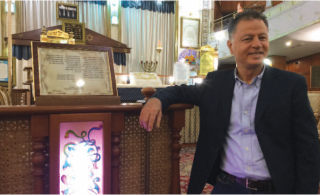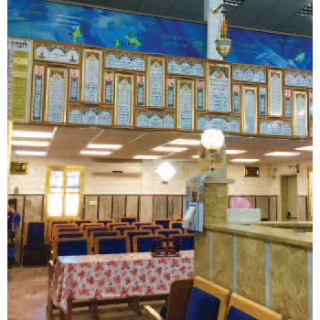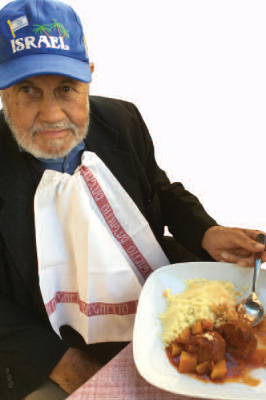The Least Known Exodus
Story of the Jews of Libya
In Italian author Primo Levi's first book on the Shoah, If This is A Man, he describes in detail, the evening that all Jews in the Italian internment camp of Fossoli were ordered to prepare for deportation the following morning.Each time I reread the passage I am struck by the haunting description of the Jews from Tripoli.
In hut 6A old Gattegno lived with his wife and numerous children and grandchildren and his sons-and daughters-in law.All the men were carpenters: they had come from Tripoli after many long journeys, and had always carried with them the tools of their trade, their kitchen utensils and their accordions and violins to play and dance to after the day's work.They were happy and pious folk.Their women were the first to silently and rapidly finish the preparations for the journey in order to have time for mourning.When all was ready, the food cooked, the bundles tied together, they unloosened their hair, took off their shoes, placed Yahrzeit candles on the ground and lit them according to the custom of their fathers, and sat on the bare soil in a circle for the lamentations, praying and weeping all the night.We collected in a group in front of their door, and we experienced within ourselves a grief that was new for us, the ancient grief of the people that has no land, the grief without hope of the exodus which is renewed every century.
Who were these Jews from Tripoli that sparked such emotion in the assimilated Italian Jew Levi? In a few sentences, he sketches a vivid picture of a Jewish communal life in Libya, unknown to many Jews; a way of life of a Maghreb community where not a single Jew now remains.
Jews had lived continuously in Libya for more than 2300 years. They first settled in Cyrenaica, what is today eastern Libya, under the Egyptian ruler Ptolemy 1, in the third century BCE; predating the Muslim conquest in 645 A D by more than 900 years.Over time the community increased by Berbers who converted to Judaism; Jews fleeing the 15th and 16th century Spanish and Portuguese Inquisition and from the 17th century Jews resettling from Livorno, Italy.By 1911, the year Ottoman rule over Libya ended and Italian control began, the Jewish population numbered 20,000; 4% of the total population of 550,000. By 1945 it had nearly doubled to 40,000.
The modern history of Libya is dated from 1911 and. paradoxically set in motion events that ultimately led to the exodus of this autochthonous community almost forty years later.
In the early 20th century much of the population of Libya was Islamic and tribal, opposed to European colonialism. Jews resided mostly on the coasts: Benghazi in the east and Tripoli in the west, where they had settled following the expulsions from Spain and Portugal. They lived with their neighbors as tradespeople, carpenters and fishermen. In Tripoli they lived in their own quarter- Haret el Yahud.The majority were traditional in behavior, poor and pious and did not embrace the start of modernization. A minority were affluent, cosmopolitan and influenced by European culture.
Under the Italians, the Jews initially were treated very well. The Italian occupation generated positive changes: a better economy and educational system; improved civil rights and opportunities to enter the colonial bureaucracy. Jewish children attended Italian run schools and spoke fluent Italian as well as Arabic and Hebrew.
The disintegration of Libyan Jewry began in the late 1930s.The Italian Fascist regime in Libya passed anti-Semitic legislation parallel to the Racial Laws instituted in Italy in 1938.Initially the laws were not strictly enforced, but by 1940, children could no longer attend Italian schools, intermarriage between Jews and Aryans was forbidden and Jews were barred from state employment and certain professions. These laws dealt a blow to the Jewish community; from June 1940 when Italy entered the war, until the liberation of Tripoli in January 1943 by the British, the Jews of Libya were pawns in a game over which they had no control.
After Italy entered the war all Jews with British or French citizenship, largely the population of Cyrenaica, were interned in the Giado concentration camp situated 240 km south of Tripoli.Health and sanitation conditions were terrible; food was scarce and many died from starvation and disease. Benghazi was conquered by the British army in June 1940 and reconquered by the Germans in May 1941, thus restoring Italian rule.After this, Jews with French citizenship were sent to Tunisia while 300 Jews with British citizenship were deported to temporary internment camps in Italy. When the Italians surrendered to the Germans in September 1943, the Jews in Italian holding camps were sent to Bergen Belsen where they all survived.
The British army including the Jewish Brigade liberated Tripoli, January 23, 1943 and Giado the following day. After liberation, the Racial Laws were repealed but in spite of this, the unrest of the war years had taken its toll. Deep painful scars remained and the situation for the Jews did not improve.
A new phase in their long history began in 1945.The Arab League's pan Islamic and anti-Zionist propaganda fanned the flames of hatred which resulted in a vicious three-day pogrom in November 1945.From November 7-9 more than 140 Jews were murdered, five synagogues destroyed and scores of homes and businesses ruined, further impoverishing the community. The 1945 anti-Jewish riots in Tripoli were the most violent against Jews in North Africa in modern times. Following the November 1945 pogrom there was a growing sense of insecurity.The pogrom was a harbinger of the end of the Jewish community in Libya.
The situation deteriorated further with the eruption of the 1948 Arab-Israeli war.In June 1948, anti-Jewish rioters in Libya killed 12 Jews and destroyed almost 300 homes. Fear coupled with the rebirth of a Jewish homeland led to the decision of the majority to emigrate.
The Jewish Agency established an office in Tripoli in 1948 to assist in emigration.They sent an emissary, Baruch Duvdevani, to help the Libyan Jews.Most lived in the cities of Tripoli and Benghazi but also were spread out in the countryside. These were religious and quite primitive and might have been left behind had it not been for the Jewish Agency. Duvdevani gathered them into the ports where they sold any belongings they had. They left with nothing and happily boarded the transit ships for Israel.The first group in 1949 consisted of 14,000 people. Menachem Arkin, a Palestinian Jew who had been a Major in the Jewish Brigade, stationed in Tripoli, welcomed the newcomers who settled in the ma'abarot around Netanya. The remaining Jews arrived in the next two years and were settled in transit camps near Tel Aviv, in Or Yehuda, in Jaffa, and on marshy ground west of Hadera.
Between 1949 until the end of 1951, when Libya gained independence, more than 30,000 Jews fled the country, 90% of the population, leaving behind a remnant of 6,000. Those who remained were affluent, with ties to family in Italy and Italian culture.
The first years in Israel were difficult. They were victims of discrimination and treated poorly by the authorities, but their rich communal life sustained them and proximity to the sea reminded them of home. They did not complain; were eager to work, and demanded from the Jewish Agency employment, housing and an end to neglect.Those who were farmers asked to be given plots of land to work, a request that was usually granted. Within the first three years they established 12 moshavim throughout Israel.By the end of 2000, there were 25 moshavim founded by Jews of Libyan origin and Italian culture.
In the mid-1950s the ma'abarot metamorphosed into towns where residents were provided with permanent housing. One of the new neighborhoods was Givat Olga, west of Hadera.Authorities built as quickly as possible, small two-story houses, each with four apartments of one and a half rooms, equipped with plumbing and electrical wiring. Compared to the tents of the transit camps, these were luxurious palaces. Families were large, wages meager, poverty deep. Populated by Tripolini, Givat Olga was home to a large number of Iraqi Jews who emigrated during the same years as well as later Moroccans, Tunisians and Yemenites.
This past November I visited Givat Olga with my niece whose mother grew up in Givat Olga in the 1960s.Most of the 1950s style two-story houses have lost their original form.As families grew the houses also expanded. The streets, haGalil and haSharon of the old town are patchworks of red tiled roofs above small balconies where vines and lemon trees are tangled together, growing up from a small front yard.The beautiful "Beit El" Beit Knesset still has the character of days gone by.
We walked through the streets on a Friday afternoon and were lucky.A door opened and a woman popped out to check who we were.She offered us a taste of the already prepared iconic Libyan Shabbat dish: chraime, a spicy fish stew simmered with tomatoes, paprika, hot peppers and curcumin, and a bite of the tangy mafrum, potatoes halved and stuffed with a ground beef mixture served over couscous.Thanking her, our hearts were full with appreciation.
At the close of December 1951, the areas of Cyrenaica, Tripolitania and Fezzan were united for the first time after centuries of rule by empires, creating a constitutional monarchy called Libya.The throne was offered to Idris, formerly Emir of Cyrenaica. The 6000 Jews in Libya were increasingly anxious. The first decade of Libyan independence was marked by nationalism that expressed itself through anti-Jewish and anti-Israeli policies.The new Libyan government had no intention of including Jews in the political life of the new state.Soon after independence, Jewish emigration to Israel was restricted; Libyan Jews were no longer permitted to visit relatives in Israel; those who emigrated could not return.By the early 1960's civil liberties were denied to Jews.They could not vote, hold public office or serve in the army or police force. Jews were prohibited from acquiring new property, receive passports, or certification of their Libyan citizenship.They were victims of harassment and assault; there was a progressive deterioration in the situation before 1967.Jews were uneasy but chose to ignore the looming dangers.
In June 1967, the Six Day War broke out between Israel and her Arab neighbors.Instigated by Egyptian President Nasser's pan-Arab appeals, Libyans took to the streets attacking the remaining Jews, mainly in Tripoli.Everyone ran for shelter, crowding into homes of friends and neighbors, locked in without food or water, afraid to walk in the streets.Those who did venture out were murdered.The realization that their trepidations since 1949 were justified was painful for the deeply rooted community.
Amos Guetta, now one of the leaders of the Libyan Jewish Community in Rome, was a 12-year-old boy in Tripoli at the time of the final pogrom.Last November, 2018 he graciously arranged an interview for me with him, at the beautiful Beit Knesset "Beit El" on Via Padova in Rome, where he shared his memories with me of the final exodus of the Jews from Libya and the beginning of a new community in Rome.
For Amos Guetta, the feeling of fear has never left him.Secluded at home, hungry, not knowing the whereabouts of his family and the hara afire, the pogrom left scars that remain with him more than fifty years later.The pogrom was decisive; the 6000 remaining Jews must leave.
By the time calm was restored, eighteen were dead; the community shattered.With almost no international protest, little attention was given to the fate of the community.It is a matter for speculation about what could have happened during the following weeks, had it not been for the courage of Italy's ambassador to Libya, Cesare Pasquarelli, who ordered all Italian diplomatic missions in the country to extend protection to Jews.Within a few weeks, an airlift was organized by Alitalia to fly all the Jews to Rome under the protection of the Italian Navy. The refugees were allowed one suitcase and the equivalent of fifty dollars. Four thousand refugees continued on to Israel to join families, while approximately 2,000 decided to remain in Rome.
The Piazza Bologna area of Rome was chosen because a few families from Tripoli had already settled there. The piazza itself is a leafy tree filled square that first served as a meeting place to locate family and friends after the airlift.It remains today the focal point of gatherings and celebrations.Surrounded by majestic buildings and boulevards radiating from the piazza, it is reminiscent of Tripoli.
When the refugees arrived in Rome, they established at home what had existed in Tripoli.Every house was virtually a small factory where foods, spices and drinks were created. Orange blossoms were distilled for use in cooking, grapes distilled and seasoned with anise for arak. Pungent smells of curcumin and paprika filled the air, especially on Fridays when the traditional foods were prepared for Shabbat. Unlike Roman Jews, the custom is to invite guests to the Shabbat table to enjoy mafrum, chraime, and bazin, an unleavened bread of barley water and salt.
Industrious and warm hearted, the Tripolini set out to find work wherever possible.Trades they were familiar with: carpentry, jewelry making, spice vendors, clothing dealers, were expanded on and improved in Rome.
Paraphrasing Amos Guetta, the presence of Jews of Libyan origin in Rome has been significant both qualitatively and quantitatively.Commerce received a significant boost thanks to the economic vitality and know-how of the Jews.Libyan Jews built a vibrant community surrounding Piazza Bologna; two lovely synagogues, a kosher café and grocery store and several Libyan Jewish restaurants that dot the area.They have been the force behind a renewed Jewish pride that strengthened and encourage Jewish tradition in Rome, a community that itself has a turbulent history, was traumatized during the Second World War, yet survived for more than 2,000 years.
At first the Roman Jews were skeptical of the newcomers, but the fact that they spoke Italian and held Italian citizenship eased their integration.Today they constitute 30% of the registered Roman Jewish population; marriages between the two groups are common, , though each group retains its nusach and customs.Ironically, had it not been for the final exodus of Jews from Tripoli in 1967, and their choice to remain in Rome, much of their precious heritage would have disappeared.In Israel it has partly blended with customs and foods of other Maghreb and Mizrachi communities that now form the unique Israeli society.
These are the resilient Jews from Tripoli that Primo Levi admired that sorrow filled night of February 21,1944, before deportation to Auschwitz. "Old Gattegno" and his family died in the camp; Primo Levi survived to tell us of them.
This past November, 2018, I visited the outstanding museum in Or Yehuda outside Tel Aviv, dedicated to the history and culture of the Libyan Jews. The town of Or Yehuda was chosen since it grew out of the ma'abara where many Libyan Jews were settled in 1949-1951. Two charming women, Nini Meghnagi and Gelsina Debasc, welcomed me warmly. They took several hours guiding me through the museum which is full with artifacts, letters, books, costumes, Torah scrolls, of the more than 2,300 years of history of the community that inhabited the territory now known as Libya. The story of the exodus from their homeland, between 1948-1951 and the final exodus in 1967, is probably the least well known of all the stories of Jews from the Maghreb or Mizrachi communities, forced to emigrate.
Museum of Libyan Jews, Moshe Hadidi Street, Or Yehuda, 03 533 6268











Comments